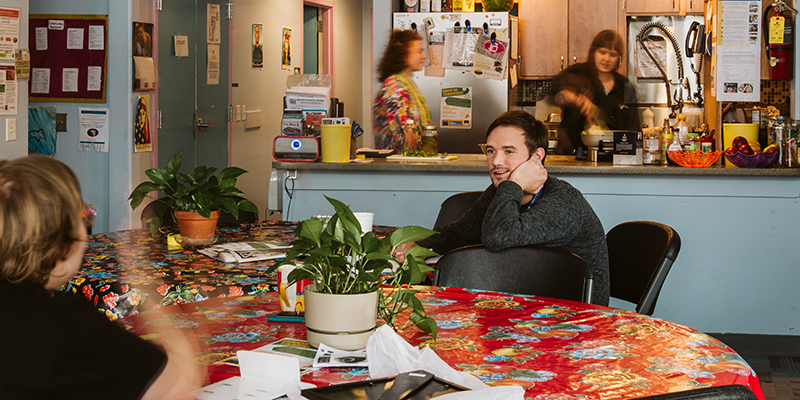This is a recent speech given by Sam Bolz, a Spectrum staff member that works in the Burlington Drop-In Center, during a KidSafe Legislative Forum. It was so genuine and powerful that we wanted to share his humble words publicly as well.

“The vast majority of the youth that we serve are “transition-aged,” people who are considered adults by the law but whose challenges are unique to their age range. While “transition-aged” is defined as youth between the ages of 16-24, I’d like to speak today about the core of that range, people aged 18-22.
Most of these young people live at the intersection of a range of marginalized identities: they are teenagers, they are experiencing homelessness, they have mental health and substance abuse problems. They are disproportionately people of color or those who identify as LGBTQ+. They might be disabled or scraping by on benefits.
In our day-to-day work we see first-hand how marginalized these youth feel in their community: they aren’t considered for jobs they’re qualified for, they’re seen as a nuisance in public, they’re targeted by police as “troublemakers,” and they’re questioned over their presumed lack of motivation to “better themselves.” It’s our job to help them navigate these systems and create safe spaces for them to grow outside the glare of the public eye.
In my experience and that of my colleagues, this dynamic stands out in particular when transition-aged youth seek care in crisis situations. Specifically, I’d like to speak to some of my experiences with these youth when they’ve tried to access intensive mental health services in our community.
Last year I accompanied a young transgender woman to the hospital. We often offer this kind of advocacy and support role for folks in severe crises. For weeks this youth had been coming to our Drop-In Center reporting increasingly frequent episodes of paranoia and psychosis, accompanied by intensifying thoughts of suicide. As her crisis deepened, we made as many referrals as we could to mental health supports like counseling, medical care, advocates for survivors.
Nothing took. And then she came to Drop-In with obvious physical marks of the last night’s suicide attempt, and an insistence that it was a matter of time before she followed through with her suicide. Yes, she had a plan. Yes, we were both terrified.
At the hospital she was told in plain language that her reported mental health symptoms could not be true given the way she presented in that moment. She was told that her recent attempt must not have been particularly serious, and that her plan to kill herself did not merit further medical attention. She was discharged after about an hour with no discernable plan of care or follow-up.
I don’t doubt that this kind of invalidation added a new layer of trauma to her experience, and that she might be less likely to seek medical care when in a future crisis because of it. Despite her traumas, she saved herself. Somehow – amazingly – she traveled by herself to a different state, got herself admitted into an inpatient facility at a hospital, and stayed there for over a month. She was ultimately discharged and admitted into a stabilization clinic in Vermont before moving into a residential mental health program.
And I will offer another brief anecdote. About when a 19-year-old, also transgender, reported to us that she was abducted for days and repeatedly assaulted before running away and making it back to the Drop-In Center. She went to the hospital, where she was seen by intake staff before getting overwhelmed and returning to Drop-In. When I went back to the hospital to support and advocate for her, she was scolded, told that she’d wasted hospital staff’s time by leaving, and that she’d have to wait longer because she left. It felt like a punishment. The forensic nurse who examined her was kind, but the damage was already done at the admission-level. She angrily refused most services and said that, if there were a next time, she’d skip the hospital altogether.
It’s really important to me that everyone here understands: I’m telling these stories not to condemn the hospital, any local clinicians, or any mental health providers who are doing an incredibly difficult job with limited resources, especially now. I understand that they have to make seemingly impossible choices, and I’m grateful for the effective care they’ve given to other Spectrum clients. I tell these stories only to show what my colleagues and I are seeing on the ground: transition-aged youth, particularly the most vulnerable, are met with skepticism and eye-rolls when they seek help in a crisis.
So, why is that?
Why are the transition-aged youth that we serve, who are among the most vulnerable folks in our society, treated like the lowest priorities in their times of need? In my opinion, the reasons that our youth aren’t taken seriously in these situations are the exact same reasons that they should be taken most seriously.
It isn’t a secret that the trauma of youth homelessness takes a toll on people’s mental health. According to a 2019 study published by researchers at the University of Southern California, 12 percent of adolescents in the United States have considered suicide, while 4 percent have attempted suicide. For youth experiencing homelessness, the study shows that 46 percent of those surveyed had attempted suicide, and that 78 percent of those who had previously attempted would continue to make attempts.
That is for youth homelessness. What happens when you add more layers of marginalization? For example, UCLA cites the 2015 Transgender Study as reporting that more than 80 percent of transgender people have seriously considered suicide in their lifetimes, and that over 40 percent make at least one attempt. These rates are so much higher than those of the general population, it’s hard to fathom.
And to put these two populations together, again consider that youth homelessness disproportionately affects people who identify as LGBTQ+, as well as people of color. We at Spectrum see these trends on the ground.
What I’m getting at is – as far as I’ve seen in this work – the more traumatized you are, the more marginalized you are, the more likely you are to be turned away in your hour of need. And I think that the opposite should be true.
So how do we start to address this trend?
To start, I think we should go back to the basics. The practice of Trauma-Informed Care is widely embraced as a baseline tool to help client-facing staff approach people in crisis with knowledge and compassion.
It’s rooted in a classic maxim in social work: do no harm. To quote from an article on the practice published by the Substance Abuse and Mental Health Services Administration, also known as SAMHSA: “Trauma-Informed Care begins with the first contact a person has with an agency; it requires all staff members (e.g., receptionists, intake personnel, direct care staff, supervisors, administrators, peer supports, board members) to recognize that the individual’s experience of trauma can greatly influence his or her receptivity to and engagement with services, interactions with staff and clients, and responsiveness to program guidelines, practices, and interventions. Trauma-Informed Care includes program policies, procedures, and practices to protect the vulnerabilities of those who have experienced trauma and those who provide trauma-related services.”
Put simply, it’s a good way of treating people with dignity and understanding when they’re at their worst. So no doubt, Trauma-Informed Care is a really helpful tool to meet the needs of the most vulnerable. But maybe we need other tools, too.
We at Spectrum have recently been told two different things: that there are more than enough beds in the state for psychiatric patients of all ages, and then that there are not. We’re not sure who to believe. But no matter who’s right, we do know that young people in psychiatric distress are turned away at alarming rates.
So what’s happening? What’s the disconnect? If the capacity does exist, why and how is the criteria for admission failing transition-aged youth? And whether the question is capacity or criteria, I think that we should start a conversation about diverting resources toward creating clinical programs that cater specifically to the needs of transition-aged youth.
Why specifically, transition-aged youth?
For one, beyond the trends I’ve just mentioned, countless studies have confirmed that the human brain continues to develop and mature for years into true adulthood. It’s uniquely sensitive and fragile in this growth period.
It’s also widely accepted that youth trauma and homelessness can lead to long-term mental health problems and chronic homelessness in adulthood. Instead of accepting that as an inevitability, what if we set aside resources to meet the needs of this unique population, one whose future has proven to have a profound effect on all of our social and economic futures?
If we can take lessons from this pandemic – like diverting resources upstream, like focusing on prevention and mitigation before the current becomes chronic – then maybe we can start to make lasting change.















Comments